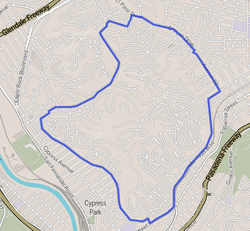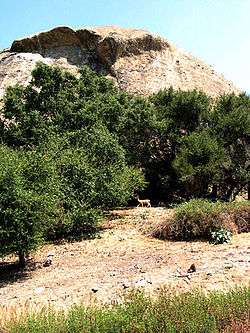Mount Washington, Los Angeles
| Mount Washington | |
|---|---|
| Neighborhoods of Los Angeles | |
 Mount Washington neighborhood, as delineated by the Los Angeles Times | |
 Mount Washington Location within Central Los Angeles | |
| Coordinates: 34°06′02″N 118°12′58″W / 34.10056°N 118.21611°W | |
| Country | United States |
| State | California |
| County | County of Los Angeles |
| City | City of Los Angeles |
| Government | |
| • City Council | José Huizar, Ed Reyes |
| • State Assembly | Kevin de León (D) |
| • State Senate | Gilbert Cedillo (D) |
| • U.S. House | Xavier Becerra (D) |
| Area[1] | |
| • Total | 1.9 sq mi (5 km2) |
| Population (2000)[1] | |
| • Total | 12,728 |
| • Density | 6,878/sq mi (2,656/km2) |
| ZIP Code | 90065, 90042 |
| Area code(s) | 1323 |
Mount Washington is a neighborhood in the San Rafael Hills of Northeast Los Angeles, California. Founded in 1909, it is a historic area with one high-achieving elementary school within it. It includes the Southwest Museum, the world headquarters of the Self-Realization Fellowship, and Eldred Street, one of the three steepest streets in Los Angeles.
History
In the 19th century the area was part of Rancho San Rafael.
Mount Washington was founded in 1909 as a subdivision laid out by real estate developer Robert Marsh. Marsh built the Mount Washington Hotel at the summit of Mount Washington, and the Los Angeles and Mount Washington Railway Company was soon established as a funicular railway up the hill as an alternative to constructing roads up the area's steep hillsides. The railway operated until January 1919.[2]
By the late 2000s, the neighborhood attracted middle- and upper-income residents, mostly whites, Latinos, and Asians.[3]
The district is generally considered the most affluent area of the East Side, and also contains the region's largest concentration of non-Latino whites (though not as affluent as the neighboring cities of South Pasadena, San Marino, and southwest Pasadena; for instance, 30% of census tract 1851 (Mount Washington) has incomes of $100,000 or greater; while 35% of census tract 4806 (South Pasadena) has incomes of $100,000 or greater).[3] The "beauty and the quirky nature of Mount Washington" has inspired songs.[4]
In recent years, many homebuyers have become attracted to the area as a relatively affordable alternative to the Westside.[5]
Population
The 2000 U.S. census counted 12,728 residents in the 1.85-square-mile Mount Washington neighborhood—or 6,878 people per square mile, an average population density for the city. In 2008, the city estimated that the resident population had increased to 13,531.[6]
In 2008 the median age for residents was 33, about average for the city and the county. The percentage of never-married men (40.9%) was among the county's highest.[6]
According to the Mapping L.A. project of the Los Angeles Times, based on the 2000 census, the neighborhood was "moderately diverse" ethnically, with a high percentage of Latino residents. The breakdown was Latinos, 61.2%; whites, 20.8%; Asians, 12.8% ; blacks, 2.6%; and others, 2.7%. Mexico (44.4%) and El Salvador (9.6%) were the most common places of birth for the 41.5% of the residents who were born abroad—an average figure for Los Angeles.[6]
Over the last decade, the demographics have been shifting. As of 2009, Mount Washington has no racial or ethnic group in a majority. According to the American Community Survey (2009), Mount Washington is 33% White, 3% Black, 47% Latino, 9% Asian, and 7% other (census tract 1851).[3] The only census tract entirely within Mount Washington's boundaries is census tract 1851 (census tracts 1852 and 1862 are also in Mount Washington but also include surrounding neighborhoods). Census tract 1851 is on the east side of Mount Washington, and includes Moon Canyon Park and the Carlin G. Smith Recreation area; and it is extremely racially and ethnically diverse, even for Los Angeles.
The 2000 census found that the median yearly household income in 2008 dollars was $57,725, about average for the city. The average household size of 2.9 people was about the same as Los Angeles as a whole. Renters occupied 45.1% of the housing stock and house- or apartment-owners held 54.9%.[6]
Mount Washington (tract 1851) has a median household income of about $60,000; and 30% of its residents have a household income greater than $100,000 per year; neighboring census tracts shared with Mount Washington and other neighborhoods also have somewhat similar income data.[3]
Geography
According to the Mapping L.A. project, Mount Washington is bordered on the north by Eagle Rock, on the east by Highland Park, on the south, southwest and west by Cypress Park and on the northwest by Glassell Park.[7][8][9]
Mount Washington is split between Los Angeles City Council districts 1 and 14[10] and is part of California's 31st congressional district. The neighborhood lies mostly within ZIP code 90065, with an eastern portion in 90042, and the area code is 323.
Education
Twenty-five percent of Mount Washington residents aged 25 and older had earned a four-year degree by 2000, an average figure for both the city and the county.[6] One school lies within the neighborhood — Mount Washington Elementary School, LAUSD, at 3981 San Rafael Avenue.[11] Mount Washington students "consistently score among the top schools in Los Angeles on the Academic Performance Index."[12]
Transportation
Owing to its hilly geography, Mount Washington lacks major arterial streets. However, nearby transportation options allow easy access to Downtown Los Angeles, Pasadena, and other areas of Los Angeles. Several major thoroughfares run through adjacent neighborhoods, including Figueroa Street, San Fernando Road, York Boulevard, and Eagle Rock Boulevard. The area is also served by several freeways: the Pasadena Freeway, Glendale Freeway, and Golden State Freeway. The Metro Gold Line serves southeastern parts of the neighborhood with a station near the Southwest Museum.
Notable places
- Southwest Museum
- World Headquarters of the Self-Realization Fellowship
- Eldred Street, between Avenue 50 and Cross Avenue on the northeast side of Mount Washington, with a slope of 33% grade, is one of the three steepest streets in Los Angeles[13] and one of the steepest streets in the world (Baldwin Street, Dunedin, New Zealand is 35% and Bradford Street in San Francisco is 41%[14]). Bottom of the steep climb is 34°06′31″N 118°12′29″W / 34.10853°N 118.2081°W
Notable residents
- Jack Smith, former Los Angeles Times columnist[15][16]
- Antonio Villaraigosa, former mayor of Los Angeles and former speaker of the State Assembly[17]
See also
References
- 1 2 "Mapping L.A.". The Los Angeles Times. Retrieved 2010-05-27.
- ↑ Mount Washington Railway
- 1 2 3 4 "N.Y. Times, Mapping America: Every City, Every Block". The New York Times. 2010-12-13. Retrieved 2010-12-17.
- ↑ "A Mount Washington Love Song". Eastsider. Retrieved 2010-12-17.
- ↑ New York Times article, retrieved 20 May 2008
- 1 2 3 4 5 "Mount Washington," Mapping L.A., Los Angeles Times
- ↑ Colored map, Mapping L.A., Los Angeles Times
- ↑ "Northeast L.A.," Mapping L.A., Los Angeles Times
- ↑ Bing maps
- ↑ LA Council District 14 Map
- ↑ "Mount Washington: Schools," Mapping L.A., Los Angeles Times
- ↑ "Mount Washington Elementary PTA"
- ↑ "Getting the Slant on L.A.'s Steepest Street"
- ↑ "The Real Top 10 List of Steepest Streets in San Francisco". 7x7. 2016-02-11. Retrieved 2016-04-15.
- ↑ Layne Murphy, "Jack Smith - Mount Washington Favorite Son", Mount Washington Homeowners Alliance, Retrieved December 4, 2015.
- ↑ Myrna Oliver, "Denise Smith, 83; Wife of Jack Smith Was a Key Figure in His Columns", Los Angeles Times, April 13, 2004.
- ↑ Duke Helfand, "Despite His Plea to Save Water, Mayor and Other Leaders Are Heavy Users", Los Angeles Times, August 10, 2007
External links
| Wikimedia Commons has media related to Mount Washington, Los Angeles. |
- Mount Washington page at the Mapping L.A. project
- History of the Mount Washington hotel and funicular
- Arroyo Seco Neighborhood Council, serving Mount Washington
- History of Mount Washington
 |
Forest Lawn Memorial Park, Glendale | Eagle Rock | Pasadena |  |
| Silver Lake | |
Ernest E. Debs Regional Park | ||
| ||||
| | ||||
| Los Angeles River & Elysian Park | Lincoln Heights | Montecito Heights |
